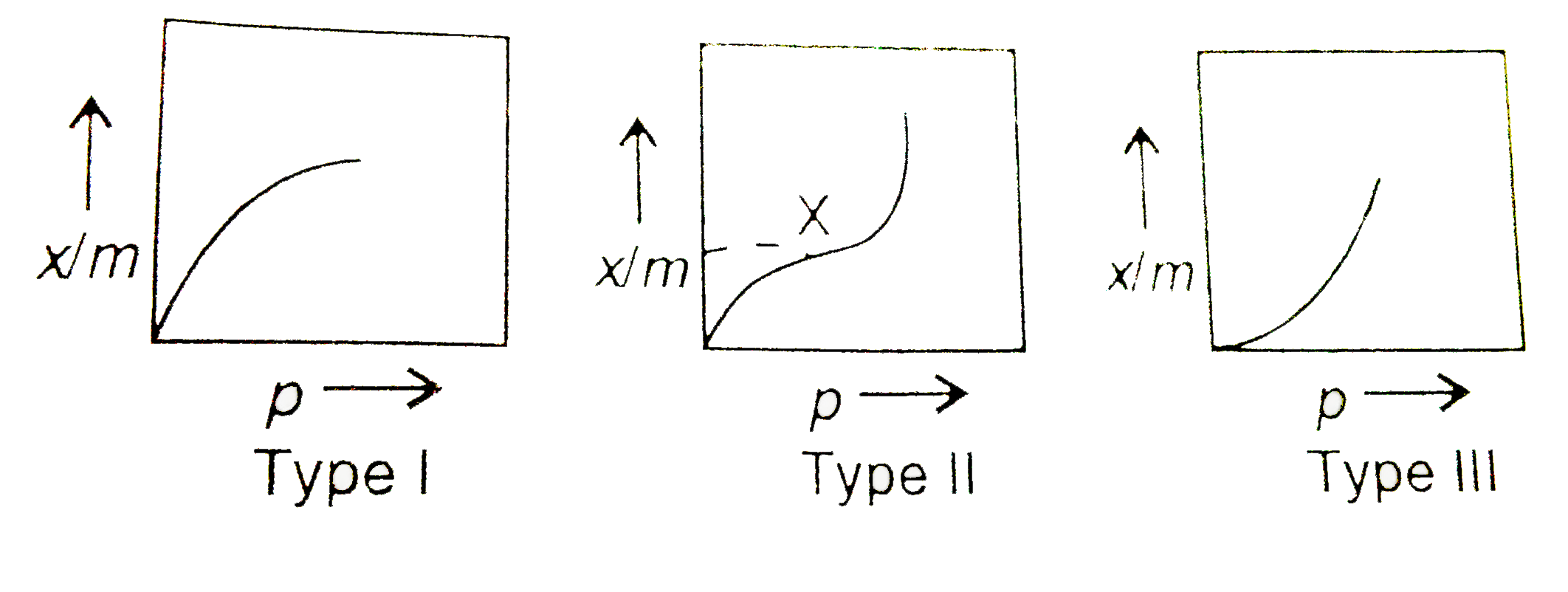The variation of p(x/m) as a function of p when Lanmuir's is isotherm is valid is :




The correct Answer is:2
Topper's Solved these Questions
- SURFACE CHEMISTRYBOOK - RESONANCECHAPTER - SURFACE CHEMISTRYEXERCISE - Solved Examples
9 Videos
- SURFACE CHEMISTRYBOOK - RESONANCECHAPTER - SURFACE CHEMISTRYEXERCISE - Solved Problems
11 Videos
- STRUCTURAL IDENTIFICATIONBOOK - RESONANCECHAPTER - STRUCTURAL IDENTIFICATIONEXERCISE - Advanced level Problems (Part-III)
12 Videos
- TEST PAPERSBOOK - RESONANCECHAPTER - TEST PAPERSEXERCISE - PT-03
1 Videos
Similar Questions
Knowledge Check
The relation p(p+1)>1 is valid when :
Ap≥−1Bp>−1Cp<−1D−1<p<0The relation pP+1>1 is valid when :
Ap≥−1Bp>−1Cp<−1D−1<p<0The amount of gas adsorbed (x/m) is the function of temperature and pressure, which can be shown as under
xm= f(p,T)
The variation x/m and p, at constant temperature is known as adsorption isotherm
i.e., x/m=f(p) at constant temperature
Seven type of physisorption isotherms are known. Some of them are shown below

Physisorption Type I. Where there is formation of monolayer on the surface of adsorbent, this type of curve is obtained.
Physisorption Type II. The transition point 'X' of this physisorption isotherm indicates, that the formation of mono layer is complete and that of multilayer is started.
Physisorption Type III. This isotherm has no transition point. In this type of curve, the multimolecular starts before the completion of monomolecular layer.
On the basis of this comprehension, answer teh following question from the physisorption isotherm of a gas on a solid shown as under.

The point Y of physisorption isotherm correctly representsAformation of monolayerBformation of multilayerCfirst monolayer formation thereafter the formation of multilayerDnone
The amount of gas adsorbed (x/m) is the function of temperature and pressure, which can be shown as under
xm= f(p,T)
The variation x/m and p, at constant temperature is known as adsorption isotherm
i.e., x/m=f(p) at constant temperature
Seven type of physisorption isotherms are known. Some of them are shown below

Physisorption Type I. Where there is formation of monolayer on the surface of adsorbent, this type of curve is obtained.
Physisorption Type II. The transition point 'X' of this physisorption isotherm indicates, that the formation of mono layer is complete and that of multilayer is started.
Physisorption Type III. This isotherm has no transition point. In this type of curve, the multimolecular starts before the completion of monomolecular layer.
On the basis of this comprehension, answer teh following question from the physisorption isotherm of a gas on a solid shown as under.

The portion ''OX'' of the physisorption isotherm represents
View SolutionThe amount of gas adsorbed (x/m) is the function of temperature and pressure, which can be shown as under
xm= f(p,T)
The variation x/m and p, at constant temperature is known as adsorption isotherm
i.e., x/m=f(p) at constant temperature
Seven type of physisorption isotherms are known. Some of them are shown below

Physisorption Type I. Where there is formation of monolayer on the surface of adsorbent, this type of curve is obtained.
Physisorption Type II. The transition point 'X' of this physisorption isotherm indicates, that the formation of mono layer is complete and that of multilayer is started.
Physisorption Type III. This isotherm has no transition point. In this type of curve, the multimolecular starts before the completion of monomolecular layer.
On the basis of this comprehension, answer teh following question from the physisorption isotherm of a gas on a solid shown as under.

The point Z of the physisorption correctly represents
View SolutionThe amount of gas adsorbed (x/m) is the function of temperature and pressure, which can be shown as under
xm= f(p,T)
The variation x/m and p, at constant temperature is known as adsorption isotherm
i.e., x/m=f(p) at constant temperature
Seven type of physisorption isotherms are known. Some of them are shown below

Physisorption Type I. Where there is formation of monolayer on the surface of adsorbent, this type of curve is obtained.
Physisorption Type II. The transition point 'X' of this physisorption isotherm indicates, that the formation of mono layer is complete and that of multilayer is started.
Physisorption Type III. This isotherm has no transition point. In this type of curve, the multimolecular starts before the completion of monomolecular layer.
On the basis of this comprehension, answer teh following question from the physisorption isotherm of a gas on a solid shown as under.

The portion XY of the curve correctly represents
View SolutionWhen stauration is attained in terms of adsorption, variation of (x/m) and c (concentration) is given by the portion of the isotherm

View SolutionAdsorption of gas follows Freundlich adsorption isotherm. If x is the mass of the gas adsorbed on mass m of the adsrobent , the correct plot of xm versus p is :
View Solution
